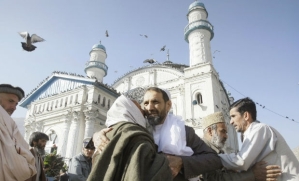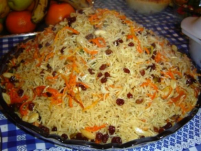Afghanistan’s crossroads position in Asia has subjected it to constant invasion and conquest throughout its long recorded history. Even now, conflict has had its impact on the Afghan culture which has influenced education.
Afghan culture has been around for a very long time, tracing its history to at least the time of the Achaemenes Empire. The type of work that people engage in is divided along ethnic and regional lines in Afghanistan. According to CIA the world factbook, the major ethnic groups in Afghanistan are Pashtuns, Tajiks, Uzbek, Hazaras, Turkmans, Balochs, and Chahar Aimaqs. The other 4% of other minor ethnic divisions, consists of Nuristani, Pashayees, Pamiries, Qirghiz and some others. Afghanistan is translated to “House of the Afghans” or “Land of Afghans”. The nation’s official languages are Dari and Pashtu. Most of the other languages are tribal and rural society languages with different regions of the country having their own native language such as Uzbeki, Turkmani, Pashaie and some others. Although there are differences a majority of the Afghans live by the same tradition. In particular, Afghans celebrate the Islamic traditional holidays, dress the same, consume the same food, listen to the same music, speak more than one language, and look at the world with somewhat similar perspectives.
The festive holiday celebrated by Afghans is ‘Nawroz’, the New Year celebration, which occurs on March 21 and beginning of the first day of the solar calendar. Nawroz, literally meaning ‘new day, is celebrated with picnics. The festival has its roots in Zoroastrianism, a religion brought from Persia long before the rise of Islam. During the celebrations, delicious and huge amounts of food are prepared. Two dishes, samanak and haft-mewah are special dishes of Nawroz. Haft-mewah consists of seven fruits and nuts that symbolize the coming of spring. Samanak is a dessert made of wheat and sugar that can take two days to prepare.
As Muslims, Afghans celebrate Muslim holidays, too. The two most important holidays are Eid-e-Fitr and Eid-e-Qurban. Eid-e-Fitr marks the end of Ramadan, the month of fasting associated with the lunar calendar. These holidays take place eleven to twelve days earlier each year, because the Arabic lunar calendar is eleven or twelve days shorter than the solar calendar that Afghans follow. Eid-e-Qurban, also known as Eid-al-Adha, marks the preparation for Hajj.
Eid-e-Qurban is celebrated because of slaughtering of a sheep or goat to commemorate Abraham’s sacrificial slaying of a sheep instead of his son Isaac. The slaughtered animal will be divided into three equal parts for poor, relatives and family. There are some other national holidays including Arafa, Ashura (Martyrdom of Imam Hussain), Moulowd (Birth of the Prophet), Formation of the Islamic State’s Victory, Worker’s Day, Remembrance Day for Martyrs & Disabled, Independence Day, and some others.
In the art section, Afghanistan used to be very good in art and poetry. For instance, the world’s first oil painting was found in Afghanistan, one of the most famous art eras was Gandhara art between the 1st and 7th century. Poetry is considered as a form of art. Since poetry has always been one of the major educational pillars in the region it is integrated into the culture. Classic Persian and Pashtu poetry plays an important role in the Afghan culture. Some of the very well-known Afghan poets and authors from the 10th to 15th centuries are Mawlana Jalaludin Rumi Balkhi, Rabya Balkhi, Khwaja Abdullah Ansari, Nasir Khisraw, Mawlana Jami, Sannaie, Farrukhi Sistani and some others. Some of these poets praised the kings of their time and used to say poems at different occasions and used to have poetry competitions. Contemporary Persian language poets and writers include Khalilullah Khalili and Sufi Ashqari, Khushal Khattak, Qahar Asey, and some others.
The main dishes served in Afghanistan vary depending on the region. However, they are being served in every place throughout the country and everyone knows how to make each dish. The main dishes served among afghan people are rice, meat, wheat products and some other ingredients. The common dishes using rice are different kinds of Palaws, such as, Qabli palaw, Uz abaki, palaw, Sabzi palaw, Chalaw, Shola, Kichri and the dishes using meat are various kinds of Kababs, fried meat, cooked and steamed meat and so on. The dishes made out of wheat are, Naan which is very common and served in every meal during the day. The special dishes from wheat products are Ashak, Manto, Malida, and Cakes.
Family is considered very important and of a very high value to all Afghan people. Additionally, families are highly dependent upon one another to meet many aspects of everyday life. Family roles are complex and they change depending upon ethnicity and region. The family remains the single most important institution in Afghan society. Characteristically, Afghan families like to get married to their relatives whom they have known for a long time. For instance, cross-cousin marriages are preferred. After getting married, the girl moves to her husband’s place. Mostly men work outside the home to bring food for the females and females stay at home and try to deal with household obligations. This is still very common in practice even if the women are somehow educated. Marriage is overall one of the main barriers that stops women from pursuing further education. Why women would like to give up her desire is because of family respect and love. Polygamy, or multiple wives, is permitted, but it has different conditions. However, it is no longer so widely practiced. Early child marriages and giving girls away is one way of ending feuds, political alliances between families that causes most of the females to suffer in their lives and give up pursuing education just because one of their family members especially males are victims of a crime. In addition, Afghan culture is rich in social customs. Afghans tend to be very social and ties among families and friends are very strong.
Like the other people from around the world, Afghans love sports and there are several kinds of traditional sports. Afghans are well-known for their traditional sport which is ‘Buzkashi’. Other famous sports in Afghanistan are Pahlwani (wrestling), Football (soccer), Cricket, Fighter-kites among others. Due to some cultural norms while people watch sports they gamble and that gambling can have a very negative effect on their children education. The one who gambles might lose most of his land and property which will raise a form of enmity among people in the tribes and may be afraid of being killed in a tribal feud so they keep their children at home and stop sending them to schools.






